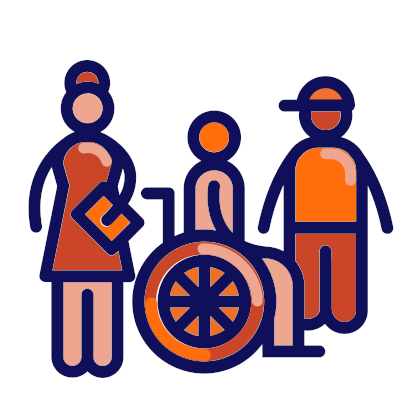Improving well-being at school

Since well-being has many facets, improving students’ well-being in schools requires a whole-school approach, involving both teachers and parents.
Schools should provide lessons focused on the responsible use of the Internet, the need to adopt a healthy lifestyle and how to prevent or cope with health problems, in collaboration with those involved, including health and social services, local authorities and civil society organisations.
Facts & figures
About 60% of school students report getting very tense when they study.[1]
Just over 60% of girls and 40% boys say they feel very anxious about doing tests at school, even when they are well prepared.[2]
Over 70% of parents say they would choose to send their children to a school with below-average exam results if students were happy there.[3]
What is well-being?
Well-being is the experience of health and happiness. It includes mental and physical health, physical and emotional safety, and a feeling of belonging, sense of purpose, achievement and success.
Well-being is a broad concept and covers a range of psychological and physical abilities. Five major types of well-being are said to be:
- Emotional well-being – the ability to be resilient, manage one’s emotions and generate emotions that lead to good feelings
- Physical well-being – the ability to improve the functioning of one’s body through healthy eating and good exercise habits
- Social well-being – the ability to communicate, develop meaningful relationships with others and create one’s own emotional support network
- Workplace well-being – the ability to pursue one’s own interests, beliefs and values in order to gain meaning and happiness in life and professional enrichment
- Societal well-being – the ability to participate in an active community or culture.
Overall well-being depends on all these types of functioning to an extent.[4]
“Having meaning and purpose is integral to people’s sense of well-being. Well-being involves far more than happiness, and accomplishments go far beyond test success.”[5]
Why is well-being important at school?
Well-being is important at school because schools have an essential role to play in supporting students to make healthy lifestyle choices and understand the effects of their choices on their health and well-being. Childhood and adolescence is a critical period in the development of long-term attitudes towards personal well-being and lifestyle choices. The social and emotional skills, knowledge and behaviours that young people learn in the classroom help them build resilience and set the pattern for how they will manage their physical and mental health throughout their lives.
Schools are able to provide students with reliable information and deepen their understanding of the choices they face. They are also able to provide students with the intellectual skills required to reflect critically on these choices and on the influences that society brings to bear on them, including through peer pressure, advertising, social media and family and cultural values.
There is a direct link between well-being and academic achievement and vice versa, i.e. well-being is a crucial prerequisite for achievement and achievement is essential for well-being. Physical activity is associated with improved learning and the ability to concentrate. Strong, supportive relationships provide students with the emotional resources to step out of their intellectual ‘comfort zone’ and explore new ideas and ways of thinking, which is fundamental to educational achievement.
Well-being is also important for developing important democratic competences. Positive emotions are associated with the development of flexibility and adaptability, openness to other cultures and beliefs, self-efficacy and tolerance of ambiguity, all of which lie at the heart of the Council of Europe Reference Framework of Competences for Democratic Culture.
What are the challenges?
One of the challenges of trying to promote young people’s well-being in school is the multi-faceted nature of well-being. There are a number of different types of well-being, all of which need to be promoted to some extent to create an overall sense of well-being in a person. So, it is not possible to improve students’ well-being at school through single interventions or activities. Rather it requires the development of a ‘culture’ of well-being throughout the whole school and the active involvement of the whole staff, teaching and non-teaching, which can be difficult to achieve.
The promotion of well-being may sometimes appear to conflict with other school priorities, such as academic standards. Unreasonably high expectations, a regime of constant testing or an over-emphasis on the importance of academic performance may actually undermine student well-being.
In many cases schools do not have the freedom to make the changes to school life which might most benefit student well-being. They may have little control, for example, over formal examinations and tests, the content of curricula, the length of the school day or the physical school environment.
Nor have schools control over the many out-of-school influences on student well-being. What happens in the home and the family, local communities or social media can have as much, if not more, influence on student well-being as anything in school.
Finally, developing a sense of well-being in students is made all the more difficult when school staff themselves do not have a positive sense of well-being. Well-being at work is strongly related to stress. Stress at work is related to workload, quality of professional relationships, level of autonomy, clarity about one’s role, availability of support and the opportunity to be involved in changes which affect one’s professional life. High levels of stress can lead to demotivation, lack of job satisfaction and poor physical and mental health, which has a knock-on effect on students’ own well-being.
How can schools get active?
Addressing student well-being at school begins with helping students feel they are each known and valued as an individual in her or his own right, and that school life has a meaning and purpose for them. This can be achieved in a variety of small ways, the cumulative effect of which can have a very powerful influence on students’ sense of well-being. These include:
- providing opportunities for all members of the school community to participate in meaningful decision-making in school, e.g. through consultations, opinion surveys, referenda, electing class representatives, student parliaments, focus groups, in-class feedback on learning activities, and an element of student choice in relation to topics taught and teaching methods used;
- developing a welcoming environment where everyone at school can feel supported and safe through access to meaningful activities, e.g. clubs, societies, interest groups and associations dealing with issues of concern to young people, including health;
- taking steps to reduce the anxiety students feel about examinations and testing through the introduction of less stressful forms of assessment, e.g. formative assessment, peer assessment and involving students in the identification of their own assessment needs;
- using teaching methods that contribute to a positive classroom climate and well-being, e.g. cooperative learning, student-centred methods, self-organised time, outdoor activities;
- finding curriculum opportunities to talk about well-being issues with students, e.g. healthy eating, exercise, substance abuse, positive relationships;
- integrating democratic citizenship and education for intercultural understanding into different school subjects and extra-curricular activities, e.g. openness to other cultures in Religious Education, knowledge and critical understanding of human rights in Social Science, empathy in Literature;
- introducing student-led forms of conflict management and approaches to bullying and harassment, e.g. peer mediation, restorative justice;
- improving the physical environment of the school to make it more student-friendly, e.g. new furniture and fittings, carpeted areas, appropriate colour schemes, safe toilet areas, recreational areas;
- encouraging healthier eating by providing healthy options in the school canteen, e.g. avoiding high amounts of sugar, saturated fats and salt;
- working with parents to enhance students’ achievement and sense of purpose in school, e.g. on healthy food, safe internet use and home-school communications.
Individual initiatives like these can be brought together at the whole-school level through a policy development process which ‘mainstreams’ well-being as a school issue. This means giving attention to the potential effects of new policies on individual well-being - of students, teachers and others. Addressing student well-being at school always goes hand in hand with action to protect the health and well-being of teachers and other staff at school.
[1] OECD (2017). PISA 2015 Results (Volume III), p.40. Students’ Well-Being. Paris, France: OECD Publishing.
[3] Cowburn & Blow, ‘Wise up - Prioritising wellbeing in schools’
[4] Psychology Today, January 2019.
[5] Hargreaves & Shirley (2018), ‘Well-being and Success. Opposites that need to attract’.
 Resources on Improving well-being at school
Resources on Improving well-being at school
 Related schools projects
Related schools projects
Address: Chkhorotsku municipality, village Akhuti
Country: Georgia
Project: Democracy in my glasses
 Working language during the project:
Working language during the project:
- Georgian
- English
 Themes of the Council of Europe project “FREE to SPEAK, SAFE to LEARN - Democratic Schools for All” covered:
Themes of the Council of Europe project “FREE to SPEAK, SAFE to LEARN - Democratic Schools for All” covered:
- Making children’s and students’ voices heard
- Tackling discrimination
- Improving well-being at school
 Competences from the Reference Framework of Competences for Democratic Culture (CDC) addressed and where / how they were integrated:
Competences from the Reference Framework of Competences for Democratic Culture (CDC) addressed and where / how they were integrated:
- Valuing human dignity and human rights
The students watched an animated film. After watching and reviewing the animated film, the students worked independently on posters showing the importance of assessing human dignity and rights. - Respect
After learning about human rights, students prepared posters and slogans showing that respect for different people is necessary and important. While working on the posters, students developed respect for a different people. - Autonomous learning skills
The students involved in the project independently made "colored glasses", made posters, slogans, where they presented the democratic vision seen through their eyes.
 Target group age range:
Target group age range:
- 5-11
- 11-15
- 15-19
 Level of education:
Level of education:
- Primary education
- Lower secondary education
- Upper secondary education
Short description of the project:
Within the reference framework of competences for democratic culture, a short-term educational project was planned and implemented in Akhuti Community Public School No. 1, in which 45 students and 25 teachers participated. Within the framework of the project, the elementary school students developed a priority topic defined by the National Curriculum: human rights; what are the challenges facing human rights in social networks, online platforms and remote communications? The following issues were identified within the project: Equality, conflict, bullying on social platforms and in real life. The following disciplines were integrated in the project: Civic education, Georgian art. The following target concepts were developed within the project:
- Democracy (Human Rights, Legal Documents, Principles of Democracy);
- Civic participation;
- Socialization.
The elementary students involved in the project found and processed information about bullying, conflict and equality. They read information on the internet; They also read the Council of Europe’s Reference Framework of Competences for Democratic Culture. They interviewed teachers and listened to what bullying means. The information retrieved was transferred to a flip chart in a list of bullet points and presentation material was prepared for primary school students. Part of the group found an animated film on the Internet that well illustrates the essence of bullying, oppression and the need for equality.
Students involved in the project made colourful, large, fun glasses from a variety of resources (cardboard paper, markers). These were distributed to elementary students involved in the project, who were asked to use their own eyes to imagine what they see when they see bullying.
What equality means and why is it necessary? The students involved in the project conducted a workshop with middle-school students. An animated film about bullying was discussed. The youngest pupils expressed their opinions: “How democracy is seen through their glasses?", How is conflict and bullying seen?”, “What do they see through their glasses?”. One complex task was developed within the project. Elementary school students (15- 4th graders) created posters with other elementary school students to show what democracy is, why it is important in terms of equality. Why is bullying condemned? How does a person feel when they are oppressed? The students jointly developed the recommendations and wrote them down on the posters in a list of bullet points: how to protect yourself from bullying in social networking and online communication? The students came up with slogans which convey well the main message of the posters: "Democracy in my glasses".
The students made coloured glasses for the final meeting, using cardboard papers and markers. These were distributed to the guests entering the exhibition hall. A poster exhibition and presentation were subsequently held. The presentation was covered live on the school social network. The students involved in the project stood in front of their own posters and delivered their concluding words - "Democracy through my glasses."
For the final phase of the project, the project team organised flyers and invited public relations’ representatives from the local municipality to the event, who covered the final phase of the project. Representatives of the school board of trustees (parents, teachers, students) were invited to the event, to listen to presentations by the students on the nature of democratic culture and the challenges that people face when interacting on social networks. Students involved in the project presented posters to the visitors in the gallery.
The school council, together with representatives of the public relations department of the local municipality, plan to conduct a joint project in the region’s schools, enabling students to work on the problem of bullying. A joint conference is planned to be held at the Local Resource Centre, where schools will present their product related to bullying and human rights.
 Aims/objectives
Aims/objectives
- Collaboration of basic and elementary students;
- Provision of information on bullying, oppression and equality at the elementary and basic levels;
- Strengthening empathy and developing collaborative skills.
 Expected results/outcomes
Expected results/outcomes
- Basic and elementary students will jointly develop the product provided by the Project;
- Students will develop their social skills through collaboration.
 Changes
Changes
The school culture was enhanced when a product was created based on the collaboration of basic and elementary students.
 Challenges you faced
Challenges you faced
- Establishing objective criteria for evaluating the exhibition work.
- Lack of digital competences and skills required to follow pandemic regulations.
- Increasing students’ motivation during pandemic regulations
 Time-frame of the project:
Time-frame of the project:
The project was implemented for a period of two months
 Council of Europe materials on citizenship and human rights education used while preparing or implementing your practice:
Council of Europe materials on citizenship and human rights education used while preparing or implementing your practice:
- Reference Framework of Competences for Democratic Culture
- Addressing violence in schools through EDC/HRE
- All Different – All Equal
- We CAN!







